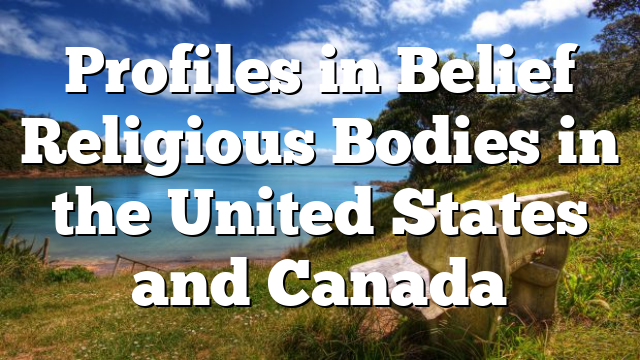Click to join the conversation with over 500,000 Pentecostal believers and scholars
Click to get our FREE MOBILE APP and stay connected
| PentecostalTheology.com



BOOK REVIEW SECTION Arthur Carl Piepkorn, Profiles in Belief Religious Bodies in the United States and Canada, 7 vols. (New York: Harper & Row, 1976) and J. Gordon Melton, The Encyclopedia of the American Religions, 2 vols. (Wilmington, North Carolina: McGrath Publishing Company, 1978). Reviewed by Dr. Charles E. Jones, Clarion State College, Clarion, PA. Not since the publication of the first edition of The Small Sects In America by Elmer T. Clark, in 1937, have the Holiness and Pentecostal movements been blessed with such serious attention as in the last five years. Recent additions to scholarship on these movements are Profiles in Belief, by the late Arthur Carl Piepkorn, and The Encyclopedia of American Religions, by J. Gordon Melton, Piepkorn, who devoted much of his life to gathering data, was Professor of Systematic Theology at the Concordia Seminary in St. Louis. Profiles in Belief is projected to run to 7 volumes; volume 3, published this year, is devoted to the Holiness and Pentecostal movements. Melton, a United Methodist pastor in the Chicago area and Director of the Institute for the Study of Religion, has devoted chapters 7 and 8 of his Encyclopedia of American Religions to the Holiness and Pentecostal movements. Both works are landmarks in their field and unlikely to be superceded in our time. Piepkom’s work is undoubtedly the fairest appraisal by an outsider of the theologies of groups associated with the Holiness and Pentecostal movements. Peipkorn relies upon spokesmen from within each body and gives an objective summary of the theology of each. The summary of doctrine is preceded by a brief historical sketch and followed by an analysis of present organizational trends in each group. The quality of Piepkorn’s appraisal can hardly be over-emphasized as it is excellent, marred only by the fact that he did not live to oversee publication, a task performed by his colleague, John H. Tietjen, currently of Christ Seminary-Seminex. Treatment of the Holiness movement is organized generally under two heads: a history of the movement, followed by descriptions of related churches and associations. A third section is devoted to social action bodies such as the Salvation Army. The section on the Pentecostal movement is divided into four categories: (1) Trinitarian bodies, (2) the Church of God, )Cleveland, Tennes- see) and related organizations, (3) Oneness bodies, and (4) miscellaneous other bodies. The text is simply unsurpassed for its clarity and sympathetic objectivity, but is married by some factual errors (names such as Vivian A. Dake (p. 11) and Howard A. Goss (p. 256) are misspelled and the Church of God (Jerusalem Acres) is identified as Church of God (1957 Reformation) without indication of the more common designation. – 59- ========1========In attitude, Melton’s treatment of the two movements is like that of Frank Mead’s Handbook of Denominations. Melton is much more concerned with organizational data than is Piepkorn. He is more conventionally objective. The review of each movement is grouped by race and by theological emphasis. This pattern is too detailed, for it breaks down at times. For instance, black groups are included with white groups on the Oneness category, only to be omitted from the section on black churches which follows. It is inevitable that errors in fact, creep into a major work of this kind. Names, such as Agnes Ozman and Gilroy, California, are misspelled, and the Fire-Baptized Holiness Church (Wesleyan) is reported to have 22,260 members in 53 congregations. (In 1962 only 1,007 members were claimed in 53 churches.) It is painful to me as the author of the standard bibliographic guide to the Holiness movement, a work which included Wesleyan-Arminian Pentecostal denominations as well, to see some errors that I made in previous work, perpetuated. For instance, the Philadelphia-based Calvary Holiness Church, a splinter of the Brethren in Christ, is confused with a British-based group of this same name which merged with the Church of the Nazarene in 1955. Melton, like myself, must pay the personal price of regret for such errors as a normal consequence of trying the impossible. Scholars interested in either of the movements will be eternally in debt to both Arthur Carl Piepkorn and J. Gordon Melton. It is fair to say that American Holiness and Pentecostal believers have never had a kinder critic than Piepkorn. Both works deserve inclusion in any serious collection on either movement. Rex Davis, Locusts and Wild Honey (The Risk Book Series; World Council of Churches, 150 route de Ferney, 1211 Geneva 20, Switzerland; 1978), 112 pp. Reviewed by Kenneth D. Gill, coordinator, The Institute for Investigation and Communication of Mexico, Mexico City. To me the locust is a symbol of the charismatic renewal … The question here is whether or not the locust brings devastation or sustenance. How far is it sent by the Lord at this time with a message to the churches, a message which is both a threat and promise? The wild honey is a symbol of the promise that we want to see fulfilled, the hope of unity, and the knowledge of love. It is, for me, much more the lure of an ecumenism which has leapt out of the confines of official negotiations. It is an ecumenism which constantly invites us to taste, even at the risk of death, the future. (p. viii) – 60- ========2========Canon Rex David currently Subdean of Lincoln Cathedral, England, was formerly a staff member of the World Council of Churches. There he was involved with developing dialogue with the Pentecostal/Charismatic movement from 1972 through 1977. This volume contains his personal evaluation of the Charismatic Renewal as he sees it interrelating with the Ecumenical Movement. Davis gives us a summary of the World Council’s interest in the Charis- matic Renewal. At first the WCC wanted to keep its distance. Efforts of such persons as, Walter Hollenweger, a world authority on Pentecostalism, and David du Plessis, a well-known Pentecostal minister, to change this met with only limited success. In 1973, this posture changed. Davis credits those Pentecostal churches who joined the World Council with helping to “bridge the divide.” The first half of the book begins with a short history of Pentecostalism. Davis then relates highlights of the Charismatic Movement and discusses its relationship to the Jesus Movement. He concludes with some interesting obser- vations and comparisons with the Pentecostal/Charismatic Movement in the “Third World.” In the second half, “Characteristics, Criticisms and Challenges,” Davis gives his analysis of the contemporary Charismatic Renewal. Much of what he has to say is directed toward the more liturgical churches. He sees the movement as characterized by lay participation in leadership roles and spontaneity in worship. The main thrust of the book involves the central concerns of the Ecu- menicals : How does the Charismatic Renewal promote church unity and social concern? Davis finds a very promising trend toward unity. The Charismatic Renewal crosses denomination barriers easily. It operates on personal ex- perience rather than on an official church decision-making level. , Davis sees the emphasis on prophecy as driving the Charismatic Movement ° “into the issues of social engagement and action.” Taking prophecy seriously is one way of discerning God’s Word for our time. Davis concludes that the Charismatic and Ecumenical Movements share much in common. He urges joint efforts toward realizing their goals. “A convergence between these two aspects of contemporary religious development could be the Holy Spirit’s scenario for the restoration . of the Church to both unity and fulness of Life.” To these in the Pentecostal/Charismatic campe, who feel the two move- ments are so diverse that cooperation is impossible, this book from an ecumenical perspective provides a basis for serious reconsideration. -61- ========3========Robert Bahr, Least of All Saints: The Story of Aimee Semple McPherson (Engle- wood Cliffs, NJ: Prentice-Hall, Inc., 1979) 308 pp. Reviewed by Mary Kendzora, Pastor, Etna Green United Methodist Church, Etna Green, Indiana. This “speculative biography” of Aimee Semple McPherson, one of Ameri- ca’s most noted and controversial evangelists is written in a new literary genre emerging in the second half of the twentieth century, the docu-drama. This literary form enables an author to make a serious figure in history come alive through the invention of conversations, and other details characteristic of the subject but which cannot be documented historically. Bahr’s interpretive effort through this vehicle, in this reviewer’s opinion, is disappointing. The treatment of her life begins with her conversion (More to Robert Semple than to Christ) at age seventeen, and includes such additional events as: her consequent marriage to Robert Semple’ their missionary trip to China, and Robert’s death from malaria; her return to America and her second marriage to Harold McPherson; her breaking away from the “unspiritual” McPherson to evangelize America; her success at Angelus Temple in Los Angeles; the many scandals that followed her through later life; and finally, her death. Equally significant, in the mind of the reviewer are events omitted: her childhood, her third husband, World War II and several minor episodes which do not readily lend themselves to the picture of the heroine this author wishes to portray. For heroine she is; Robert Bahr is a man in love with his subject, freely warning the reader that he is creating his version of the “perfect heroine.” If he must sacrifice a bit of truth along the way in his presentation of “Sister Aimee,” then it is sacrificed. The result is an impulsive and shallow woman, naive to the point of the ludicrous. She has her low points: a graphically violent episode with Harold McPherson; trivial feuding with her mother and daughter; the rather tawdry episode surrounding her “staged” drowning and kidnapping. But Bahr is still able to find Aimee attractive, though his concept of perfection shows itself to , be flawed in the childlike, dependent and trusting nature of the sexually frustrated evangelist who is his perfect heroine. In my judgement this is a biography that totally misses the personality of the main character. There is no depth or growth in this ficionalized Aimee. Rather, she emerges from the cocoon of her humble beginnings as a full-grown gospel butterfly, fluttering unchanged through the rest of her life. The real Aimee only peeks through occasionally: her toughness, inventiveness, her bitterness, are almost nowhere to be found. Her terrific genius is overlooked at the expense of her vanity. The book ultimately reveals more of the author’s conception of the perfect woman than it does about what the real Aimee Semple McPherson was like. – 62- ========4========Aimee Semple McPherson is too important a figure in Pentecostalism to be ignored. This work is a reminder that a serious, balanced work is needed to assess the life of this controversial person. Such a work should be cast in the light of the characteristics and goals of the movement which she helped to shape and in which she played such a profound role. – 63- ========5========


